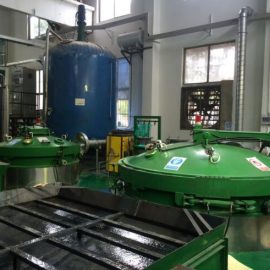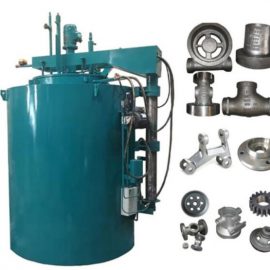Nitriding Furnace Safety Operation Rules
1. Purpose
Clarify the operation requirements of nitriding equipment to avoid equipment safety accidents and quality accidents caused by equipment reasons.
2. Scope of application
Suitable for operation control of nitriding production equipment
3. Responsibilities
3.1 Nitrogen inspects the condition of the equipment every day, and guides and supervises the operators to work as required
3.2 After pre-job training, nitriding workers shall operate in strict accordance with the requirements of this work instruction
4. Operating procedures of nitriding furnace
4.1 Main application: Through the process of heating liquid ammonia, air pressure, etc., the ammonia is decomposed, so as to achieve the effect of improving the hardness of the mold.
4.2 Main technical parameters
Maximum allowable temperature: 700℃
Voltage: 380V
Power: 75±10%KW
Mass: 3900kg
4.3 Operator: Nitriding engineer
4.4 Inspection items and preparations before operation
4.4.1 When the electric furnace and the control cabinet are all in place and installed, they are confirmed by professionals, and the mechanical, electrical, water pipes, ammonia gas inlet and outlet pipes, thermocouples, and temperature instruments have been checked one by one and the necessary trial operation has been carried out. After that, the oven can be used.
4.4.2 Understand the basic structure and working principle of circuit control cabinets, instruments, etc., and be familiar with the layout of gas lines, ammonia gas pipes, water inlet and outlet pipes, and temperature control systems of the electric furnace.
4.4.3 Keep the control cabinet clean and tidy, and do not allow heavy or dirty objects to be placed on it.
4.4.4 Check the water cooling and lubricating oil of the fan bearing to ensure that it is not short of oil and dry.
4.4.5 Check whether the cooling water pipeline, ammonia gas medium pipeline and exhaust pipeline are unobstructed.
4.4.6 Check the interface of ammonia gas pipeline, there should be no gas leakage.
4.4.7 Check whether the electrical circuit is normal; whether the sealing ring is elastic, if there is no elasticity, it needs to be replaced with a new ring.
4.48 Do a good job [Daily report on the operation of the controllable pit nitriding furnace]
4.5 Operation and precautions
4.5.1 Cut off the power supply and stop supplying nitrogen.
4.5.2 Open the furnace cover, and hoist it into the mold material frame with a row hoist to ensure that the interval between the material frame and the furnace is uniform.
4.5.3 Close the furnace cover, press the sealing silicone ring into the groove of the furnace, tighten the tightening wrench, and press the furnace cover to make it airtight.
4.5.4 Unscrew the high-pressure valve of the ammonia bottle to adjust the pressure to 0.4-1.0Mpa, then unscrew the low-pressure valve to adjust the working pressure to 0.2-0.4Mpa.
4.5.6 Press the process adjustment instrument setting button
4.5.6 Input the command according to the process regulations, and check whether the command is correct, adjust the handle to the automatic position, and turn on the power to heat up.
4.5.7 When the temperature rises above 100°C, it should be cooled by water, and the fan should be turned on when the temperature reaches above 300°C. When the temperature reaches below 300°C, turn off the fan, turn off the water valve below 100°C, and stop cooling.
4.5.8 When the second stage nitriding is over, stop heating, turn the power switch to the off position and turn on the blower for cooling.
4.5.9 Out of the furnace: cut off the power supply, stop the supply of ammonia and blast cooling, turn off the fan, open the furnace cover, and hoist the frame out of the furnace.
4.6 Daily maintenance and maintenance
4.6.1 Because the furnace tank and the air guide are both thin-walled steel sleeves, they are easily deformed by force, so care should be taken not to collide, and it is forbidden to throw objects into the furnace tank.
4.6.2 Because the nitrided liner material is easy to become hard and brittle after repeated use, which will increase the brittleness of the weld, so the welding should be checked regularly and strengthened.
4.6.3 Check the air deflector frequently. If it is found to be deformed after long-term use, it should be re-rolled and rounded, and the cracked weld should be re-welded.
4.6.4 The furnace tank should be checked frequently, and the brittle cracks of the welding seam should be repaired in time.
4.6.5 Always inject oil at the support shaft seat of the lifting shaft to ensure flexible rotation.
4.6.6 Replace the sealing parts such as asbestos rope and vacuum rubber tube every 2-3 months to ensure good heat insulation and sealing.
4.6.7 After the nitriding furnace has been used for a long time, since the nitrogen absorption of the muffle 1Cr18Ni9Ti and the furnace pot will increase its decomposition rate and make it unstable, which will affect the quality of nitriding, the nitrogen removal treatment should be carried out after nitriding 10-20 furnaces. When denitrifying:
The temperature is controlled between 650-700°C and kept for 6 hours;
If there is no ammonia gas, CO2 gas can be appropriately introduced;
Put the iron filings in the internal medicine of the furnace, keep it warm for 6 hours, and then cool down the furnace to below 200 °C to take out the iron filings;
After the furnace has cooled to room temperature, clean the muffle and furnace pot with water, a copper wire brush and sandpaper;
After cleaning, nitriding can be continued by drying the furnace at a low temperature (about 120°C).
Study on QPQ Nitriding Process of 42CrMo Piston Rod Study on QPQ Treatment Technology of 05Cr17Ni4Cu4Nb Material Surface Gear Carburizing Heat Treatment Furnace Structure Composition And introduction



Contact us
Your email address will not be published. Required fields are marked *